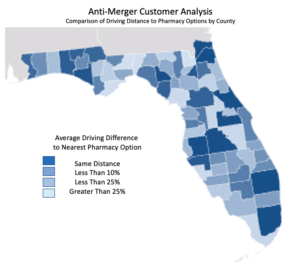Database Discovery is an extension to the traditional e-discovery approach using enterprise business data as a source of insight. Rather than limit yourself to documents, emails, and text messages in your discovery practice, you can add transactional data from enterprise systems like Salesforce, Oracle, SAP, Concur, and more. Read on for more details on a specific case where database discovery was pivotal in forming a data-driven defense argument.
Case Study: Pharmacy Merger Anti-Monopoly Challenge
A well-known retail drug store chain entered into an acquisition bid for a local chain based primarily in the southeastern United States. The acquisition was challenged under monopoly concerns, stating that one company would control too much of the pharmaceutical retail options across the region, restricting choice and fair-market competition for customers.
Solution: The key to this case was establishing buying patterns by customers in the region in question. The legal team set out to show how far the average customer was willing to go to purchase drugs before the acquisition, and then illustrate other pharmacy options to the population within that average radius.
This case highlighted a number of database discovery features, in addition to those highlighted in the first scenario:
- Geospatial Analysis – Using the addresses of the pharmacies and customers in the region, the team was able to construct buying patterns and habits based on combining the purchase data with address data. Using geolocation data, the team was able to compute an average distance traveled by each customer for drug purchases.
- Mapping/Visualization – Once the average distance traveled was calculated, the team was able to visualize the market on maps post-acquisition. They were able to import locations of the remaining independent pharmacies and show through graphical displays the areas that were served by multiple pharmacy options. To be more realistic, the distances traveled were measured against maps and not “as the crow flies” – so the actual driving time/distance was accurately represented.
The resulting analysis provided a clear, data-driven definition of the customer segments and the distance they would travel to purchase prescriptions from alternative pharmacies. Each segment could be visualized by state, county, or city/town address. See below for an option of viewing the data aggregated by county across the state of Florida.

To learn more about this case and others where Database Discovery was employed, download our White Paper entitled: “Database Discovery: Extend Traditional E-Discovery with Enterprise Business Data.”
Sapling Data has more than 8 years experience building data analytics solutions and tools. Our Database Discovery platform enables legal and compliance teams to build a consolidated, cloud-based data warehouse for monitoring, investigation, and reporting needs.
